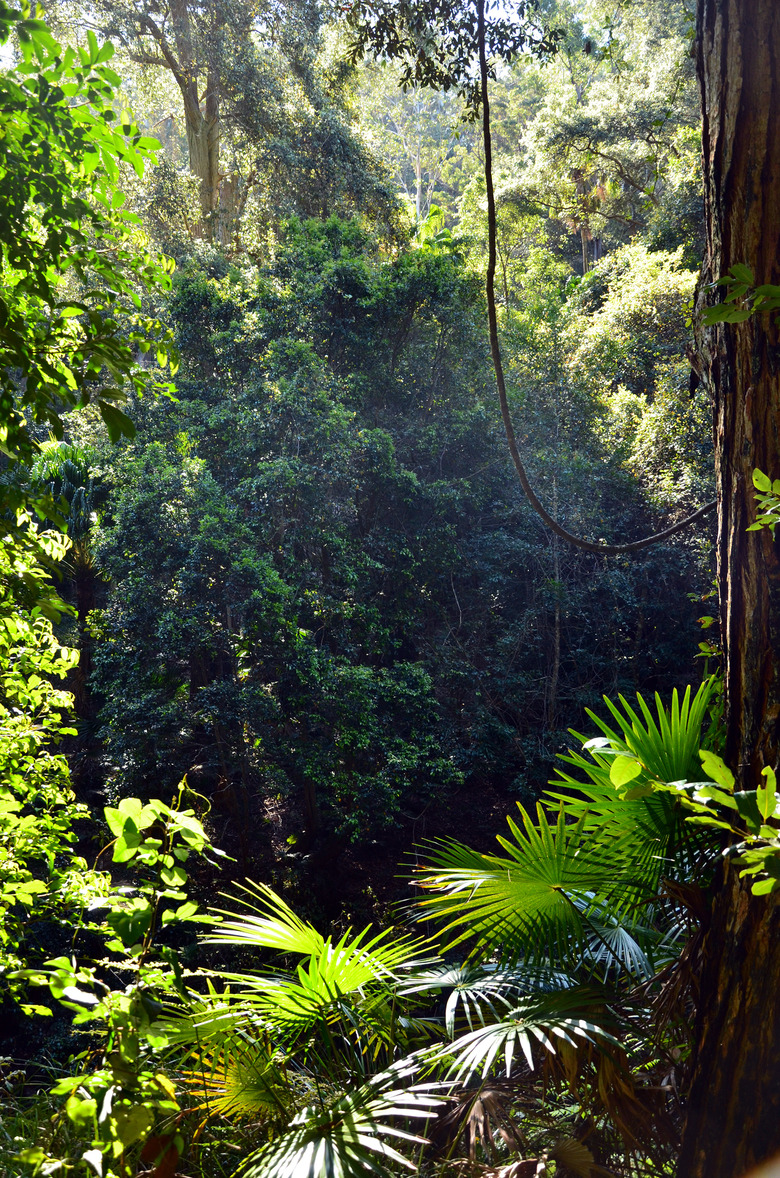Characteristics Of Tropical Soils
Tropical forests comprise the most highly biodiverse regions of the world. The lush forests represent complex ecosystems that support numerous plants, animals, fungi and microorganisms. At first glance, such a rich environment might lead one to think that the soils of tropical forests must be rich in nutrients. But as it happens, and as farmers of such lands have discovered, often tropical soils are not very fertile at all.
TL;DR (Too Long; Didn't Read)
Tropical soils are not generally very fertile, despite the rich diversity of plant life that grows in them. The tall trees of a tropical forest contribute leaf litter that decomposes into the soil and provides nutrient cycling. Tropical soils tend to be acidic and nutrient-poor due to the erosion of minerals from excessive rainfall.
Building Soil From Above
Building Soil From Above
Tropical rainforest trees extend high above the forest floor. Their tall canopies reach upward to capture more sunlight at their tops, converting that sunlight into energy for the trees via photosynthesis. Far below them, there is little room for other plants to grow, and not much sunlight since the trees cover the ground from above.
When tropical rainforest trees lose leaves, that leaf litter builds up on the forest floor below, and over time this decays. Detritivores like fungi and bacteria work to decompose this leaf litter, releasing any nutrients in it for other organisms to access.
Abundant Rainfall’s Effect
Abundant Rainfall's Effect
Tropical forests receive a range of precipitation based on their type. In tropical rainforests, as opposed to tropical dry forests, rainfall amounts can range from over a meter to as much as three meters a year. This rain has to go somewhere, and while the many plants of rainforests use rainfall, some of the precipitation becomes runoff.
The abundant rainfall in tropical forests helps those forests retain a great deal of water and aids cloud seeding and rainfall patterns, a feedback system that is important for biodiversity.
Features of Tropical Soils
Features of Tropical Soils
Tropical soils bear characteristics that vary based on forest structure and location. Some areas of the Amazon River basin possess white, sandy soils formed via erosion. In addition to sandy soils, gravel and clay soils can be found in tropical forests. These soils have had many of their nutrients washed away by the extraordinary rainfall. Nevertheless, the forests are dense and plentiful.
The process at work here is a form of nutrient cycling, a process in which the decayed organic matter from leaf litter provides nutrients from the plants above, and this is taken up by the roots.
Tropical soils, because of their leached nutrients, tend to be acidic. They also possess a quality of filtration called lixiviation thanks to the cation exchange capacity (CEC) of the soils. The low CEC value of some tropical soils indicates that the soil is highly filtered and retains few of its nutrients. This again underlines the importance of nutrient cycling of organic matter because the plants have adapted to poor soils that do not offer their own nutrients.
Nutrient Cycling in Old-Growth Tropical Forests
Nutrient Cycling in Old-Growth Tropical Forests
In old-growth riparian tropical forests there is high complexity to the forest structure, and the plant and soil correlation is strong. With higher canopies, there is more primary production, and more leaf litter is produced. This aids resource availability to the organisms that decompose the litter.
Tropical Soils and Vegetation Relationships
Tropical Soils and Vegetation Relationships
Soil types, topography, and other abiotic factors contribute to the different kinds of vegetation that thrive in tropical forests. The more diverse a forest is, the greater its soil fertility tends to be. When compared to a tropical savanna, tropical forests offer a more nutrient-rich habitat.
Tropical forests that are not considered rainforests have different nutrient contents to their soils. For example, tropical dry forest soils contain more aluminum in some habitats.
The Importance of Tropical Soils in Conservation
The Importance of Tropical Soils in Conservation
As land use of tropical forests increased due to agriculture, tropical soils lost even more nutrients due to deforestation. Combating the acidic nature of the soil led farmers to add lime, which while helpful in lowering soil acidity, damaged microfauna in the soils.
The delicate balance of tropical forests requires conservation efforts to maintain the unique ecosystems and their related flora and fauna, both high in the canopy and in the earth beneath it.
References
- World Wildlife Fund: Wonder Trees and Plants on the World's Poorest Soils
- Journal of Plant Ecology: The Influence of Soil on Vegetation Structure and Plant Diversity in Different Tropical Savannic and Forest Habitats
- International Analog Forestry Network: Understanding Tropical Soils
- Forest Ecosystems: Decomposition and Stabilization of Organic Matter in an Old-Growth Tropical Riparian Forest: Effects of Soil Properties and Vegetation Structure
Cite This Article
MLA
Hermance, Dianne. "Characteristics Of Tropical Soils" sciencing.com, https://www.sciencing.com/characteristics-of-tropical-soils-12003774/. 20 October 2021.
APA
Hermance, Dianne. (2021, October 20). Characteristics Of Tropical Soils. sciencing.com. Retrieved from https://www.sciencing.com/characteristics-of-tropical-soils-12003774/
Chicago
Hermance, Dianne. Characteristics Of Tropical Soils last modified August 30, 2022. https://www.sciencing.com/characteristics-of-tropical-soils-12003774/
